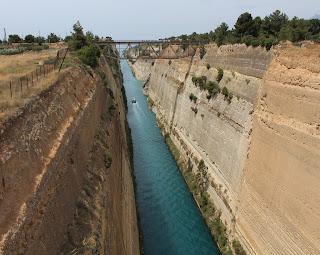The Corinth Canal separates the Peloponnese from the rest of mainland Greece. It is nearly four miles long, seventy feet wide and 260 feet above sea level at its highest point. Even today, it is an obligatory stopping off point for tourists. Even my family thought it was worth seeing, something that couldn't be said for some of the ancient sites they trekked around!
It was completed in 1893 and was a grand statement of modernisation for a country that that had only secured its independence some 60 years earlier. In 1940, some 8,600 ships a year used the canal.
The strategic point of the canal is that it saves around 185 nautical miles, avoiding the sea journey around the Peloponnese, which became dangerous for Italian shipping heading to their bases in the Dodecanese islands. These islands had been gained as a consequence of the Italo-Turkish War of 1911-12.
The book sets the scene with a brief description of the Italian invasion of Greece and the naval actions around the coast. SOE had a particular interest in Greece and from its base in Cairo organised many operations, even before the German invasion and occupation. The Admiralty wanted the canal blocked, but the RAF could not bomb it in daylight, primarily because it was outside the range of fighter cover.
Even when the British intervention force was retreating over the canal, attempts to block or mine the canal failed. It was the 2nd Fallschirmjager Regiment that dropped both sides on canal in Operation Hannibal, who seized the canal, although the New Zealanders defending it did managed to blow the bridge.
The rest of the book covers the various plans and attempts to block in canal by SOE. Most importantly, Operation Locksmith, led by Mike Cumberlege, which failed primarily because of defective weaponry. He died with the rest of his four man team in a German concentration camp.
Canals of this size are very difficult to block in this sort of operation. Finding a mine large enough for the job, yet small enough to transport, was a major challenge. Ironically, it was the Germans who completed the task as they withdrew, by dumping some 200 railway wagons in the canal, sinking block ships at either end, and filling up large parts of the canal with rubble.
This is a fascinating story, very well told. Recommended.
 |
| Allied intervention force in 15mm |


It’s arduous to search out knowledgeable individuals on this subject, but you sound like you recognize what you’re talking about! Thanks bovada casino
ReplyDeleteHistorical
ReplyDelete